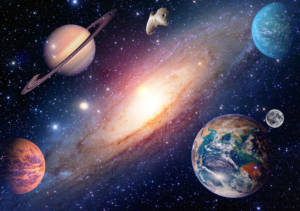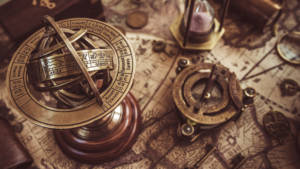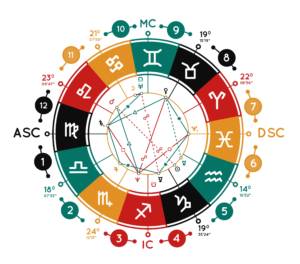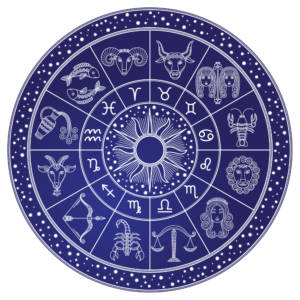Slow-Moving Signifiers: The Outer Planets in Astrology
The outer planets of our Solar System hold just as many secrets and messages as our closer neighbors. See what can these giants tell us about our lives.
Astrology is big. A quick look at the internet reveals just how ingrained it is into our modern ethos and thought. While much of it focuses on the sun and closest celestial bodies, it discerns patterns and meanings from Jupiter, Saturn, Uranus, Neptune, and Pluto. Astrologers believe that these distant outer planets may provide some wisdom of their own.
An Introduction to the Outer Planets
The outer planets exhibit a wide range of physical compositions and environments: gas giants, ice giants, and one icy chunk of rock. These celestial objects represent the vital energies of their mythological counterparts. Since they take a long time to orbit our sun, their effects are seen by astrologers as generational and more long term.
Jupiter: A Jovial and Generous King
With its 12-year orbit around our sun, Jupiter has the shortest transits of any outer planet. This massive traveler inhabits each zodiac sign for around a year, but Cafe Astrology explains that it can retrograde for up to four months at a stretch. This regal celestial body governs generosity, optimism, honor, good fortune, ethics, and as the Astro Codex reveals, higher education. Since its effects in a sign can span for up to a year, they’re thought to impact everyone born during that same time period in similar ways.
Saturn: Growth, Discipline, and Legacies
Saturn makes a complete orbit around our sun in 29.5 years, taking around two and a half years to travel through each zodiac sign. Astrostyle discusses this titan’s key energies: time, maturity, structure, karma, discipline, and prestige. If you’ve heard the phrase “Saturn return,” you likely got the impression that it can signify life-changing events. As the Cut’s Claire Comstock-Gay clarifies, Saturn comes back to its original position in our natal charts during our late 20s, our late 50s, and our mid-to-late 80s. These all coincide with major life transitions or turning points during which we may reassess our life goals and make significant new plans.
Uranus: Technology, Enlightenment, and Innovation
Uranus is a weird planet for many reasons. It’s not just the only one named for a Greek deity instead of a Roman god, but it’s also the only one that rotates on its side. Christened after the primordial sky father, it takes 84 years to orbit our sun and seven years to pass through a zodiac sign. Cafe Astrology mentions that Uranus represents invention, innovation, intuitiveness, and individuality. Astrostyle also nicknames Uranus the “mad scientist” for its association with eccentricity.
Neptune: What Lies Beneath the Surface
Discovered in 1846, Neptune got its name from the Roman god of the sea. This planet completes one orbit around the sun in 165 years, which means that it makes a 14-year trip through each zodiac sign. As a result, those energies impact large generational groups. The Astro Codex mentions that Neptune governs spirituality, dreams, illusions, artistic creation, and even addiction.
Pluto: Secrets, Transformation, and Rebirth
Reclassified as a dwarf planet in 2006, Pluto represents the Roman ruler of the Underworld. Astrostyle comments that it governs the secrets we keep within ourselves, including sensitive matters such as money, shame, and sexuality, yet it also speaks to how we share or hoard our resources. As a symbol of transformation, it signifies intense and sometimes painful changes that end in positive results. Pluto takes around 30 years to move through each sign and 248 years to orbit the sun.
Since astrology is gaining greater traction in popular culture, it’s no surprise that many people have more than a passing curiosity about their planets and signs. Jupiter, Saturn, Uranus, Neptune, and Pluto all display extreme physical characteristics. Their astrological impacts are just as massive, affecting large cohorts of people as they complete their lengthy orbits.
Dignities: Planets’ Strengths and Weaknesses Within the Signs
A planet’s effects can be positive, powerful, negative, or hindered. These positions, or planetary dignities, reveal a lot going on beneath the surface.
If you’re like many young Canadian adults, you probably have a passing interest in astrology. You at least know your Sun sign, but you may have also looked up your chart and know what your planets’ positions mean. Yet there’s always more to learn, right? Based on the signs they inhabit, a planet’s effects can be positive, powerful, negative, or hindered. These positions, also known as planetary dignities, reveal a lot more going on beneath the surface.
What Are Dignities?
In astrology, dignities are simply shorthand for each planet’s strengths and weaknesses. Writing at The Tarot Lady, astrologer Theresa Reed discusses how dignities work. All the zodiac signs and planets have their own unique energies. These energies can blend harmoniously or clash horribly. Sometimes they enhance each other to produce powerful results. At other times, a zodiac sign’s energies diminish a planet’s nature like water being dumped onto a fire.
Dignities are these specific energy combinations. Meanwhile, a planet is said to be peregrine when it doesn’t possess any dignities at all. A peregrine state doesn’t inherently have positive or negative effects since the planet’s and sign’s influences don’t impact each other in any extreme ways.
Domicile: A Planet in Its Home Turf
Each zodiac sign is ruled by at least one planet. You can think of that sign as the planet’s “home base,” but astrologers refer to the planet as being in domicile or ruler-ship. Thanks to their compatible natures, these energies blend successfully and result in positive, natural impacts. For instance, someone with a natal Mercury in Virgo is an adept communicator with a quick intellect and ability to work with large amounts of information. Astrostyle offers a helpful list of ruling planets and their corresponding signs.
Detriment: Walking on Shaky Ground
When a planet’s in the zodiac sign opposite its domicile, astrologers say that it is in detriment. This position creates an awkward clash between the planet’s and sign’s influences, rendering the planet weaker and less effective. Some astrologers consider Saturn to be in detriment when it’s in Leo. Individuals with this placement may struggle with self-expression, confidence, and spontaneity: all Leonine traits impacted by Saturn’s restraining nature.
Exaltation: Strength in Numbers
If a planet’s influence feels the most natural in a domicile sign, then it enjoys a boost of power and strength when it’s in exaltation. Astrologers believe that this is a planet’s best possible placement because its exaltation sign multiplies and enhances its native energies. Uranus in Scorpio is one great example of this. As a planet governing innovation, technology, eccentricity, and rebellion, its presence in the ultimate sign of mystery, sexuality, and intensity magnifies its influence. Uranus was exalted in Scorpio between late 1975 and late 1981, and this confluence suggests people with unorthodox approaches to sexuality and resistance against traditional norms.
Fall: Incompatibility at Its Worst
A planet’s exaltation and fall signs can be located at opposite ends of the zodiac. When a planet’s in fall, its native energies don’t function well or at all because they’re completely incongruent with those of the sign. For instance, a Venus in Virgo within someone’s natal chart may result in a person who demonstrates love through service yet struggles with being overly critical of romantic partners. That’s because the planet of love and attraction finds its influence constricted by Virgo’s practical, precise, and analytical nature.
The Relationships Between Planets and Signs
A lot of people may know their sun signs and a few planets in their charts. However, many complex ideas are involved with a chart’s interpretation. Planetary dignity is one such concept, describing the unique relationships between each planet and the sign in which it’s present. When you’re reading your chart, look at these planet-sign positions to better understand their effects.
Solar and Lunar Eclipses: Astrological Portents of Change Humans have watched the Sun and Moon for millennia. Our ancestors knew that these bodies of light allowed life on Earth to thrive, so they saw eclipses as mysterious and terrifying events. Yet modern astrology also assigns meanings to these celestial phenomena. Understanding how eclipses work in astrology requires a brief trip through science and history.
Humans have watched the Sun and Moon for millennia. Our ancestors knew that these bodies of light allowed life on Earth to thrive, so they saw eclipses as mysterious and terrifying events. Yet modern astrology also assigns meanings to these celestial phenomena. Understanding how eclipses work in astrology requires a brief trip through science and history.
Eclipses 101: Back to Astronomy Class
Eclipses are spectacular yet simple events: one celestial body moving into the shadow of another. During solar ones, the Moon passes between us and the Sun, blocking its light. Lunar ones occur when the Moon travels behind Earth and passes through its shadow.
A total solar eclipse darkens the sky, and the combined sun and moon look like a dark disc with a brilliant outer corona. Space.com explains that a total lunar eclipse produces a crimson or coppery “blood moon.” Some sunlight still passes through our atmosphere, but only red light’s long wavelengths can reach and reflect on the Moon’s surface.
The Moon and the Sun also experience partial eclipses, when one body partly blocks our view of another. Annular solar ones happen when the Moon at apogee passes in front of the Sun, appearing as dark circles with outer rims of gold light. Penumbral lunar ones result from the Moon passing through our planet’s faint outer shadow.
Eclipses in Ancient Civilizations
Historian Gonzalo Rubio reveals that eclipses were often seen as omens in ancient times. Babylonians could track and eventually predict them, but the culture seemed to worry the most about lunar eclipses. They looked for other signs to determine whether an eclipse spelled trouble, particularly to their king. Sometimes, a substitute king would be coronated while an incantation was chanted to combat evil effects. If no other ill omens appeared, the substitute was put to death and the real king returned to his throne.
Eclipses could also signal a deity in trouble or the gods’ displeasure. One even prompted two opposing armies to call a truce. Atlas Obscura’s Natasha Frost discusses the Battle of the Eclipse on May 28, 585 BCE, during which the Medes and Lydians lay down their weapons after seeing a solar eclipse and believing it to be a sign from the gods to stop fighting. Eclipses also made their way into ancient mythologies. According to physics professor Roger Culver, many describe evil entities trying to harm or swallow the Sun: wolves, dragons, frogs, and even a decapitated demon.
Eclipses in Modern Astrology
AstroStyle explains that solar and lunar eclipses occur four to six times each year. It describes them as dramatic astrological turning points, each an agent of change that brings a bit of turbulence or a “cosmic kick in the pants” that signals the need to act.
Solar ones take place during new moons, while lunar ones happen at full moons. This important distinction explains the astrological energies they bring. The Moon sits between the Sun and Earth during solar eclipses, forming a straight line and creating a conjunction. These new moon eclipses signal beginnings, possibly dramatic ones that force us outside our comfort zones. Conjunctions also blend their celestial bodies’ energies, and in this case, it’s the Sun’s ego-focused influences with the emotional ones from the Moon.
On the other hand, lunar ones create an opposition between the Sun and Moon with our planet directly between them. Full moons signal completion, but the Sun-Moon opposition creates tension between logic and emotions. Hidden or “shadow” personality aspects can arise, or we may be called to bring closure to nonbeneficial situations or patterns.
Symbolism in the Heavens
Solar and lunar eclipses fascinate us even in the 21st century. We now know the science behind them, but they still hold special meaning in astrology. As portents, eclipses are seen as calls for growth, change, and closure.
Where Do Your Planets Live? Astrology’s Horoscope Houses
Astrology is more than just zodiac signs. Horoscope house systems can map life concerns to specific celestial regions.
When many people learn about astrology, they focus mostly on the signs in which planets are positioned. Yet for professional astrologers and many enthusiasts, there’s much more to a person’s birth chart than just zodiac signs. With collections of unique energies and traits, horoscope houses can reveal much more information about an individual’s personality and life path.
A Quick History of Horoscope Houses
The Babylonians had developed a form of horoscopic astrology for drawing up natal charts by the end of the Iron Age. Astrodienst explains that the ancient Greeks were among the first to use astrological house systems. Kepler College adds that more than 20 house systems exist, each using a different approach to divide the natal chart. Today, the most popular ones are the Placidus, Koch, Equal House and Whole Sign systems. Each house represents a specific area of a person’s life.
Drawing the Houses on a Birth Chart
Birth charts are typically drawn as circles, each with two concentric rings on the perimeter. The 12 zodiac signs are placed on the outer ring, but horoscope houses are mapped on the inner ring. Astrologers use the ascendant, or rising sign, to determine the first house’s placement.
Finding an ascendant requires the person’s exact date, time and place of birth. Remember that the birth chart contains a snapshot of planet and point positions in the sky when an individual is born. The ascendant on the left side represents the eastern horizon, and the descendant on the right side signifies the western horizon. While the horizons are fixed, the zodiac sign sitting at that point shifts as the earth rotates.
Horoscope Houses and Their Meanings
Astrostyle offers a quick guide to the 12 horoscope houses. If you draw a straight line between the ascendant and descendant points on a birth chart, this splits the chart horizontally into two halves. The six horoscope houses below this axis represent personal concerns:
- First house: self, beginnings, identity, and appearances
- Second house: money, material concerns, and self-esteem
- Third house: the mind, communication, siblings, and education
- Fourth house: privacy, security, self-care, and nurturing
- Fifth house: romance, love, creativity, self-expression
- Sixth house: health, fitness, work habits, and service
Meanwhile, the six above the axis are referred to as interpersonal houses. This makes sense since the birth chart area below the axis denotes the night and the area above symbolizes the day. What’s personal remains below the surface, while social aspects are more readily seen by others in the light. Astrostyle briefly describes the six interpersonal houses:
- Seventh house: relationships, partnerships, contracts, and marriage
- Eighth house: transformation, sexuality, inheritances, and shared finances
- Ninth house: travel, higher education, wisdom, and philosophy
- Tenth house: career, long-term goals, status, and reputation
- Eleventh house: social awareness, friends, technology, and the future
- Twelfth house: endings, closure, death, and spirituality
The Blending of Planet and House Energies
Just as planet and zodiac sign energies combine, the same is true of planet and house energies. Each house has a ruling sign, so the sign’s and house’s traits tend to be similar. To understand how this works, consider a planet-house placement with compatible energies: a natal Sun in the fifth house. The Sun is Leo’s ruling planet, and Leo rules the fifth house. Self-expression, creativity, and romance would probably feel natural to a person with this placement.
Planet-house placements can also bring together less compatible influences. One example is restriction-minded Saturn appearing in moon-ruled Cancer’s fourth house. Saturn’s limiting energies could impact familial love and nurturing. A person with this placement may experience a childhood that seems cold and unloving.
Celestial Movements and Divination
Astrology is more than zodiac signs. Horoscope house systems map life concerns to specific celestial regions. Using planetary positions in these houses, astrologers try to make sense of how these energies impact our personalities and lives.
Meteor Showers: Unpacking Their Scientific and Astrological Impacts
Meteor showers have many scientific and astrological impacts on Earth and its inhabitants beyond putting on a show in the night sky.
If you’re an astrology buff, you likely follow horoscopes with close interest. You comprehend planetary transits, and retrogrades are no longer a mystery. But when astrologers mention meteor showers, you may draw a blank. What do these streaking balls of dust and light mean? Understanding their scientific astrological impacts requires a little bit of background knowledge.
The Science of Meteor Showers
Space.com describes meteor showers as remnants of broken comets or asteroids traveling through our atmosphere at high speeds. During their atmospheric entry, air friction heats up and illuminates this debris. These objects can achieve average speeds of around 30,000 miles per house and temperatures of about 3,000 degrees Fahrenheit.
Meteor showers are named after the constellations in which they’re visible. The American Meteor Society lists several regular showers, including some within zodiac constellations such as Taurus, Gemini, Leo, Capricorn, and Aquarius. Most are visible at night, but one shower, the Arietids, can only be seen during daylight hours. The Perseids are some of the most popular and brightest showers, active during July and August each year.
Showers’ recurrence and visibility result from both their parental bodies’ and Earth’s orbits. That’s because our planet must be close enough to the comet or asteroid for its debris to enter our atmosphere. The Leonids are a yearly shower, for instance, but they’re the brightest when their parent body Comet Tempel–Tuttle is on its closest approach to our sun every 33 years.
Meteor Showers in Ancient Times
Scientists theorize that a comet or large meteor may have crashed about 66 million years ago, contributing to a mass extinction that killed dinosaurs and around 75% of other life on Earth. We still see possible evidence today: a 93-mile-wide crater on the Yucatan Peninsula’s northern coast.
Typical meteor showers don’t leave such earth-shaking impacts. However, historian Eve MacDonald explains that our ancestors regarded them as omens of either great promise or impending doom. In ancient times, humans referred to many celestial objects as “stars” regardless of their actual makeup. Because some meteors trailed brilliant streaks across the sky, people eventually called them “shooting stars.”
Some comets and meteor showers were thought to herald royal births or deaths. Roman historian Gaius Suetonius Tranquillus claimed that a comet was observed after Julius Caesar’s assassination in the spring of 44 BCE. Experts propose that if this “Caesar’s Comet” truly existed, it was traveling through our solar system on a parabolic escape orbit. In other words, it made a one-time-only trip past Earth and likely won’t return.
What Do Meteor Showers Mean Today?
While modern astrologers don’t regard comets and meteor showers as bad omens, they can assign a variety of meanings to these celestial events. To comprehend their interpretive approach, consider the nature of meteor showers. They’re always trailing their parent bodies, but we don’t always see them. Well+Good’s Allie Flinn quotes astrologer Rachel Lang, who says they may signal hidden or repressed things that must resurface: emotions, spiritual insights, or unforeseen changes.
Showers can also take on different meanings depending on the constellation in which they occur and who’s doing the interpretation. Since Leonid showers appear in Leo, they could indicate new shifts in a few key areas of life: the arts, theatre, creative expression, wealth, or even seats of power. Their magnitude of visible brightness from Earth can amplify these effects.
Astrology’s Keys: Symbolism and Interpretation
Meteor showers can have a significant effect on our planet, and ancient cultures once viewed them as major portents. Today, their physical impacts are mostly limited to curious spectators viewing meteor showers in our night skies. While they no longer necessarily signal bad news in an astrological sense, they can indicate significant cultural or individual developments affecting our lives.
Understanding Yourself: What Your Rising Sign Can Tell You
Astrologers believe that each part of our birth charts tells us about ourselves and our lives. Taking a closer look at your sign can reveal some surprises.
Peruse astrology websites or hang around some enthusiasts and you’re likely to encounter a lot of discussions about rising signs. Perhaps you’ve pulled up your birth chart to find out your rising sign or heard the term “chart ruler” tossed around. Yet what does this all mean? Answering that question involves some science, geography, and a peek into the human psyche.
What Is Your Rising Sign?
Your birth chart shows quite a bit of information. Mastering the Zodiac briefly explains what each detail means, focusing on four primary elements: the Sun, the Moon, the rising sign, and the chart ruler. Mastering the Zodiac and other astrology sources sometimes refer to the rising sign as the “ascendant,” but it’s more than just a fancier word for the same concept. As Astrostyle reveals, it’s the zodiac sign that’s ascending above the eastern horizon at the time each person is born.
As you may already know, some planets and points change position more slowly than others. Consider our Moon, which makes its trip around the Earth in only 27 days. With such a short orbital period, our speedy satellite stays in each zodiac sign for only 2.5 days. The ascendant changes signs even faster than that. Depending on a location’s latitude, each sign takes anywhere between 30 minutes and three hours to cross the horizon. The earth’s axial tilt of 23.5 degrees also causes these differences, with the ascendant jumping 180 degrees or disappearing completely in extreme northern and southern locations.
Because of how quickly the rising sign changes, finding it requires knowing a precise time and place of birth. Even twins born a minute apart can have different ascendants if a sign finishes crossing the horizon before the younger one is born. If you’re not sure about your ascendant, check your birth certificate to get an accurate time of birth. You can plug this data into any free birth chart generator to see your results.
What Your Ascendant Means
You may have heard that our ascendants represent the masks that we wear, the faces that we choose to show to the world. This is one basic interpretation, but Astrostyle adds that it’s the sign of first impressions. The way you dress, your interpersonal style, your demeanor, and even how you style your hair are connected to your rising sign. It adds another layer to how you can be perceived by others. Astrologers often say that it’s one possible reason you could be mistaken for a zodiac signifier other than the one under which you were born.
Mastering the Zodiac suggests additional meanings for you. While it may speak to how you present yourself to others, it can also reveal the qualities you’re developing as you age. If we look at both points of view, the ascendant represents both the personality you show to others as well as the personality shaped by your life experiences.
Your Rising Sign and Chart Ruler
The rising sign has another important function: determining the chart ruler. In astrology-speak, the chart ruler is simply the ruling planet of your rising sign. For instance, someone with an Aries ascendant has Mars as a chart ruler. This planet exerts its influence over the entire natal chart in areas such as personality, goals, desires, and strategies for learning, relating to others, and solving problems. In our Aries ascendant example, Mars will significantly impact whatever signs and houses it’s in. This individual may love competition, testing oneself, and pushing the limits.
Astrologers believe that each part of our birth charts tells us about ourselves and our lives. The rising sign represents the impression we make on others, but it also speaks to central life themes. Taking a deeper look at your ascendant can reveal some surprising details.
Astrology 101: Signs and Planets What does it mean to have a Gemini rising sign, a Capricorn Moon, or your Venus in Leo? Astrology buffs may already get it, but you may be wondering about the significance of planetary positions in your birth chart. Understanding how sign and planet energies blend is key to comprehending how interpretive astrology works.
What does it mean to have a Gemini rising sign, a Capricorn Moon, or your Venus in Leo? Astrology buffs may already get it, but you may be wondering about the significance of planetary positions in your birth chart. Understanding how sign and planet energies blend is key to comprehending how interpretive astrology works.
Why Are Planetary Positions Important in Astrology?
Astrologers examine and interpret how a planet’s energies combine with those of its resident sign. This synergy produces certain effects based on the date, time, and location of a person’s birth. Think of these combined energies like an equation: planet plus sign equals meaning. For reference, Mystica Astrology briefly explains the qualities represented by each planet. Astrostyle also offers an extensive guide to each of the astrological signs.
The Basics of Interpretation
While celestial energy combinations are an important basis of astrological interpretation, looking at how they specifically play out in someone’s chart can also be useful. A key starting point is the primal triad consisting of the Sun, Moon, and Ascendant signs. Together, these three compose the core of an individual’s personality. The three planets that follow, Mercury, Venus, and Mars, represent concerns in our personal day-to-day lives. The five outer planets exert long-term effects and can impact generational groups due to their longer orbits.
An Example of Basic Astrological Interpretation
For an in-depth example of how interpretation can work, let’s examine the natal chart of an individual born on August 14, 1976. For brevity’s sake, we’ll only look at the first six planets and points in this chart:
- Sun in Leo
- Ascendant in Aries
- Moon in Aries
- Mercury in Virgo
- Venus in Virgo
- Mars in Virgo
The Primal Triad and Its Meanings
The Sun speaks to one’s personality, ego, and self, but it can also represent the search for identity. Meanwhile, Leo represents creativity, generosity, loyalty, and charisma. With these two energies combined, the individual in our example prefers to be passionate, generous, devoted, and expressive.
Yet the Sun is just one component of the primal triad. You’ll notice that this person’s Ascendant and Moon are both in Aries. The Ascendant, or rising sign, signifies our external selves: the masks we wear and how we present ourselves to others. Conversely, the Moon stands for our inner selves, emotions, and deepest needs.
Aries symbolizes energy, drive, will, and direct action. Others may view an Aries Ascendant personality as direct and straightforward. Those with an Aries Moon value emotional independence, direct expression, and the desire to act. Because this individual has the same rising and Moon signs, outer presentation and inner emotions won’t usually conflict with each other.
Mercury, Venus, and Mars
Astrologers also view Mercury, Venus, and Mars as critical planets. Mercury stands for communication, thought language, information gathering, and analysis. Venus represents desire and attraction on many levels: love, sexuality, and even our preferences in art, politics, and culture. Finally, Mars symbolizes human drives, motivations, aggression, and even how we choose to fight.
In our example, the natal chart shows that Mercury, Venus, and Mars are all in Virgo. As you may remember, Virgo is the sign of details, service, practicality, and modesty. This individual likely prefers a precise approach to communication and easily keeps track of details. Partners shouldn’t expect showy romantic gestures, but they’ll enjoy dedication and lasting commitment. Virgo energies temper Mars’s natural aggression, resulting in someone with focused, disciplined, and sustained efforts in reaching goals.
Putting It All Together
It’s one thing to know what zodiac signs your planets and points are in, but it’s quite another to recognize potential interpretations. That’s part of the fun with astrology: divining meanings and possibilities. Everyone deciphers details differently, but basic principles can help you understand the core meanings behind planets in your natal chart.








